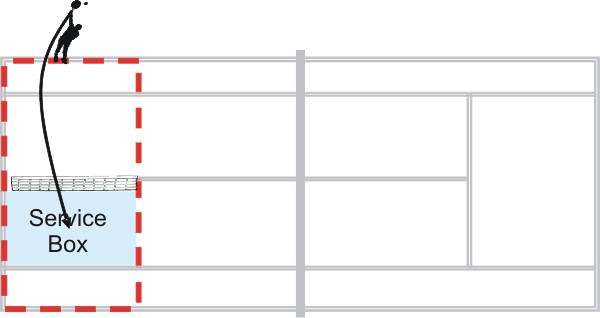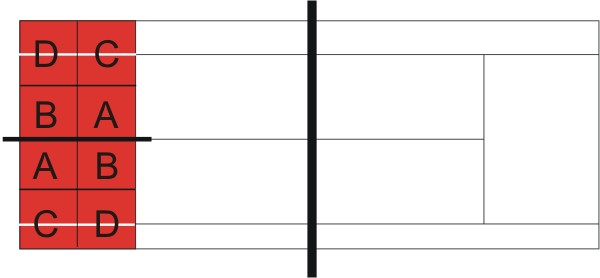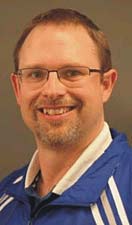|
TennisOne Lessons Developing Serve & Return Skills For ½ Court Players (5-7 Year Olds) Wayne Elderton We are currently in a series about developing 5-7 year old players using balls and courts scaled down to the size of children (Called Progressive Tennis in Canada). In the last two installments, we started our exploration of the ‘Silver’ level of skill development which is split into 4 Skill Blocks:
In our last installment, we looked at Block #2: Silver Net Play development. The main key was to develop the volley skills from the concept of a ‘catch’ to increase ‘feel’ and ‘touch’ right from the beginning. Serve Development In ½ Court tennis in Canada, we have elected not to divide the service boxes. Players are able to serve anywhere on their opponent’s court provided the ball lands in front of the singles sideline (which acts as the serviceline in ½ Court tennis).
We feel this benefits the player because he or she has more chance of success with a bigger target area. As they improve, they can explore initiating points by moving the ball around with many possibilities (which helps their ability to direct the serve). Players are also encouraged to ‘go for it’ and not constrain and ‘bump’ their serve in order to get it into a small area (which hurts their technical development).
In regards to technical development, the serve is built from an overhead throwing motion. Shaping the serve from an overhead throwing action is far more successful than ‘chaining’ the serve together by teaching the pieces (e.g. ‘down together, up together, scratch your back, etc.). Transferring from throwing to serving is a much more natural process and many subtle movements and skills can be transferred to the serve by taking this approach. During competition, players are encouraged to serve underhanded at the beginning. Now, I can hear a number of coaches saying, “players should serve overhead for real tennis!” Don’t misunderstand, encouraging underhand serves doesn’t mean the player shouldn’t be practicing overhead serving constantly. There is a short developmental phase where building a well linked overhead service action can be retarded by the player needing to get the serve in consistently. In other words, because they need to put the serve in, they abandon their good throwing action for a ‘mutated bump’ of the ball.
The player should still compete during this phase however, the goal is to develop the overhead serve action enough that, when they serve, it is with good linkage. An underhand serve allows them to compete with full tactical intention until their overhead serve is ready to be unleashed properly. Even after they are serving overhead, ½ Court players will typically serve underhand as a 2nd serve. It is a good idea for players to practice placing their underhand serve. For serving underhand, the rules of tennis apply in that the ball must be taken in the air and not bounced before it is hit. Players need to place the serve to both forehand and backhand sides. The Silver ‘Tactical grid’ can be used to identify the areas to serve into.
Once they have appropriate overhead serve linkage, they can practice placing the serve to various areas of the court in order to start a point in-charge. The same target areas that were used for the underhand serve can be used for overhead serves.
Return Development Since players are able to serve nearly anywhere in the court, returners need to be able to use both forehand and backhand to place it anywhere. Starter players should be looking to simply keep the ball in play however, Silver level players need to be able to direct the return down-the-line as well as crosscourt. To practice, the same Tactical Grid can be used. It is also a good idea to incorporate a server (rather than feeding from a basket) to keep things realistic. Right from the beginning, Silver level ½ Court players are taught appropriate tactical intentions to be a successful returner:
Technical Foundations We can use the same 5 technical fundamentals introduced in the Bronze level to mold Serve & Return skills Grip
Impact Point
Set-up
Hitting Zone
Recovery
During theses drills, coaches need to relentlessly maintain good technical fundamentals. This is much easier if the coach sets-up players cooperatively serving and returning to each other. The coach is free to circulate around and give feedback to all players. Conclusion Developing 5-7 years olds in a Progressive Tennis format is recommended by the International Tennis Federation (ITF). Their world-wide Play & Stay initiative (and the USTA Quick Start Initiative in the US) will help more players get better faster. Your comments are welcome. Let us know what you think about Wayne Elderton's article by emailing us here at TennisOne.
|


 Wayne Elderton
Wayne Elderton